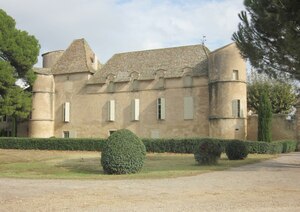Maraussan
|
Maraussan Marauçan |
||
|---|---|---|

|
|
|
| region | Occitania | |
| Department | Herault | |
| Arrondissement | Beziers | |
| Canton | Cazouls-lès-Beziers | |
| Community association | Domitienne | |
| Coordinates | 43 ° 22 ′ N , 3 ° 10 ′ E | |
| height | 8-92 m | |
| surface | 12.37 km 2 | |
| Residents | 4,414 (January 1, 2017) | |
| Population density | 357 inhabitants / km 2 | |
| Post Code | 34370 | |
| INSEE code | 34148 | |
| Website | Maraussan | |
 Maraussan - town view |
||
Maraussan (ocS | Marauçan) is a place and a French municipality with 4,414 inhabitants (as of January 1, 2017) in the Hérault department in the Occitania region .
Location and climate
The place Maraussan is located on the Orb river about 8 km (driving distance) northwest of the city center of Béziers at an altitude of about 38 m . The climate is temperate to warm; Rain (approx. 650 mm / year) falls - with the exception of the rather dry summer months - over the year.
Population development
| year | 1800 | 1851 | 1901 | 1954 | 1999 | 2017 | ||
| Residents | 684 | 976 | 1866 | 1562 | 2782 | 4414 | ||
| Sources: Cassini and INSEE | ||||||||
Despite the phylloxera crisis in viticulture, the mechanization of agriculture , the abandonment of small farms and the resulting lower need for workers, the population has grown continuously since the 19th century. The proximity to the greater Béziers area has also played a role since the middle of the 20th century.
economy
For centuries, the place was largely agricultural and self- sufficient. The sharp increase in viticulture in the 19th century contributed to monocultural tendencies; As early as 1820, around 7000 hectoliters of wine were produced, which was considered to be one of the best in Europe. Maraussan was the first wine village in Languedoc, whose winemakers decided to found a cooperative (Les Vignerons libres) in 1901 ; it was hoped for more stable prices and secure sales markets. In 1904 a cellar was built. The phylloxera crisis had hardly any impact in large parts of the Languedoc.
history
The area around Béziers had been settled around the 8th century, but it was only the Romans who brought viticulture to what was then the province of Gallia Narbonensis . Around 1230, the then Archbishop of Béziers settled here and had a church built.
Attractions
- Today's Église Saint Symphorien stands in its old location; Parts of the medieval walls were integrated into the new church. The bell tower (clocher) , however, is a work of the 19th century.
- The old town hall has a tower with a bell cage in which sirens are also housed.
- The Cave coopérative Les Vignerons libres on the southern outskirts is the oldest cooperative cellar building in the world. The motto Chacun pour Tous, Tous pour Chacun (“All for one, one for all”), borrowed from the Three Musketeers , can be found in its facade . The building has been recognized as a monument historique since 2001 .
- Surroundings
- The Château de Perdiguier , a good 1 km east of the village, was built at the end of the 13th century; However, the current state is based on changes from the 14th to 17th centuries. The building has been recognized as a monument historique since 1972 .
- The Chapelle Notre-Dame-de-la-Providence , a good 2 km west of the town, is an eclectic building from the late 19th century.


